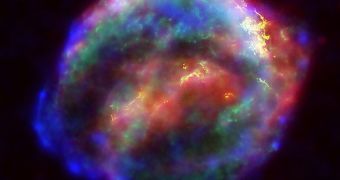About six years ago, astronomers identified a supernova that apparently defies classification, and would be better off in a class of its own. Dubbed SN 2005E, the object was found spewing out the chemical elements titanium and calcium, something that has never been observed before.
Current theories and existing observations do little to explain the readings experts took of this dying star in 2005. They imaged its light just as it reached our planet. The star itself probably died off eons ago, but the light it produced as it exploded reached us just recently.
Supernova events occur when massive stars, more than 8 times heavier than the Sun, reach the end of their burning cycle. They become unable to support nuclear fusion, on account of the fact that their hydrogen reserves are completely depleted.
When the last of the chemical is gone, the star violently sheds the outer layers of its atmosphere in a massive explosion, while at the same time its core implodes to form either a black hole or neutron star.
Of all such events that experts witnessed thus far, they have never seen a supernova remnant release calcium and titanium before. Interestingly, the new data could put a massive dent in theories now being used as a foundation for trying to find dark matter in the Milky Way.
The new research effort was led by Harvard-Smithsonian Center for Astrophysics (CfA) expert Hagai Perets and astronomer Avishay Gal-Yam, of the Weizmann Institute of Science in Rehovot, Israel.
The two say that SN 2005E is not a member of known supernova groups, Type Ia or Type II. Apparently, its progenitor may have been a low-mass white dwarf star, that lived in a binary system.
According to theory, the former stole mass from the latter until the extra material caused the ignition of a thermonuclear reaction similar to the one produced by a Type Ia supernova. The strength of this explosion may have been so great that the entire star was blown to pieces.
In the process, the helium that remained in the star – as a result of hydrogen-based nuclear fusion – was transformed into calcium and titanium, among other chemicals. These substances then went on to provide the foundation for the construction of the basic building block of life, Daily Galaxy reports.
Interestingly, the release of radioactive titanium is also triggering the production of excess positrons throughout the galaxy. One the other hand, theoretical physicists say that those positrons are produced by the annihilation of dark matter.
Experts believe that the stuff is made up of weakly-interacting massive particles (WIMP), which are their own antiparticles, and which emit antimatter electrons (positrons) as they meet and annihilate each other.
If the Milky Way's positron source can be accounted for by this newly-found type of supernova – which is directly observable – then the case for dark matter will weaken considerably.

 14 DAY TRIAL //
14 DAY TRIAL //